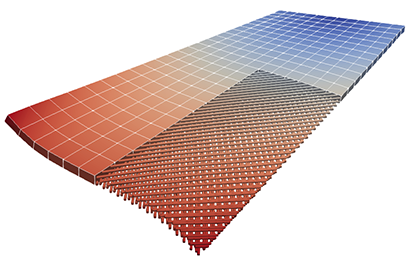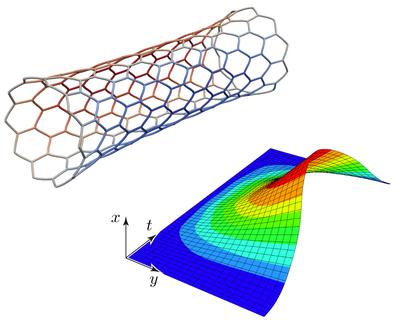The current research of our institute in the area of modeling and discretization in mechanics focuses on issues of contact and interface mechanics, mixed-dimensional modeling, coupled multi-physics, and advanced discretization techniques.
Contacts at IMCS
Contact and Interface Mechanics
IMCS is internationally acknowledged for innovative research in the field of computational contact and interface mechanics. Our efforts encompass the entire spectrum from micromechanical modeling (e.g. rough surfaces) and tribology (e.g. lubrication) to robust discretization schemes for large deformations (e.g. FEM, IGA) and efficient solution algorithms (e.g. semi-smooth Newton). One particular focus are mortar finite element methods, where contributions range from the mathematical foundations of contact formulations (e.g. stable Lagrange multiplier spaces) to engineering practice and high-performance computing (e.g. algebraic multigrid). Nonlinear beam-to-beam and beam-to-solid contact formulations for the efficient modeling of fiber-based systems round off our unique competence profile. The group carries out both fundamental research, most imporantly through DFG funding, and application-driven projects including successful industry collaborations.
Key Publications
- Bonari, J., Marulli, M.R., Hagmeyer, N., Mayr, M., Popp, A., Paggi, M. (2020): A multi-scale FEM-BEM formulation for contact mechanics between rough surfaces, Computational Mechanics, 65(3):731-749, DOI
 , arXiv
, arXiv 
- Popp, A., Wriggers, P. (Eds.) (2018): Contact Modeling for Solids and Particles, CISM International Centre for Mechanical Sciences 585, Springer International Publishing, Link

- Meier, C., Wall, W.A., Popp, A. (2017): A unified approach for beam-to-beam contact, Computer Methods in Applied Mechanics and Engineering, 315:972-1010, DOI

Current Projects
- Multi-scale modelling of thermomechanical frictional contact for complex problems in engineering
- Controllable metamaterials and smart structures
Completed Projects
- A Novel Smooth Discretization Approach for Elasto-Plastic Contact of Solid Bodies and Thin-Walled Structures
- Robust Simulation Methods for Contact, Friction, Wear and Fatigue in Blade-to-Disc Joints in Aircraft Engines
Mixed-Dimensional Modeling

The interaction between slender, fiber- or rod-like components, where one spatial dimension is significantly larger than the other two, and 3D continua (e.g., fluids or solids) is a common phenomenon in the physical world. A highly efficient approach to modeling such systems involves using 1D structural beam theories for the slender structures, while established numerical models handle the 3D continua. This necessitates a mixed-dimensional coupling approach to consistently capture the interactions between the 1D fibers and the higher-dimensional continua.
Mixed-dimensional problems present numerous challenges, both in their theoretical formulation and computational treatment. However, they are critically important for a wide range of modern engineering applications. At IMCS, we develop advanced numerical methods and high-fidelity models to address these challenges, with a particular focus on fiber-reinforced materials in solid mechanics and the fluid-structure interaction of slender structures in biomedical flows. Additionally, our group is leading research in the development of specialized solvers, such as algebraic multigrid, and the creation of parallel software to handle these complex systems efficiently.
Key Publications
- Hagmeyer, N., Mayr, M., Steinbrecher, I., Popp, A. (2022): One-way coupled fluid-beam interaction: Capturing the effect of embedded slender bodies on global fluid flow and vice versa, Advanced Modeling and Simulation in Engineering Sciences, 9:9, DOI (Open Access)
 , arXiv
, arXiv 
- Steinbrecher, I., Popp, A., Meier, C. (2021): Consistent coupling of positions and rotations for embedding 1D Cosserat beams into 3D solid volumes. Computational Mechanics, DOI (Open Access)

- Steinbrecher, I., Mayr, M., Grill, M. J., Kremheller, J., Meier, C., Popp, A. (2020): A mortar-type finite element approach for embedding 1D beams into 3D solid volumes, Computational Mechanics, 66:1377-1398, DOI (Open Access)

Current Projects
Completed Projects
- Mixed-dimensional coupling in solid mechanics
- Mixed-dimensional models for fiber/fluid interaction
- Bottom-Up Modeling of Stents and Stent Grafts for Endovascular Aortic Repair (EVAR) of Abdominal Aortic Aneurysms
Coupled Multi-Physics

The interaction between different physical fields is a core aspect of many technical and biological processes. Solutions to such problems require a profound insight into the interplay of the involved physical mechanisms and numerical methods. Researchers at IMCS address the development of mechanical models, computational methods, and scalable algorithms in the context of coupled multi-physics and interface problems, where exactly this interplay between physics and numerics will facilitate computational robustness and efficiency.
IMCS offers long-standing expertise in discretization techniques for coupling terms as well as the development of efficient and robust solution strategies for coupled problems. Prototype applications are surface-coupled phenomena such as fluid-structure interaction or mixed-dimensional couplings such as fiber/solid or fiber/fluid interaction.
Key Publications
- Hagmeyer, N., Mayr, M., Popp, A. (2024): A fully coupled regularized mortar-type finite element approach for embedding one-dimensional fibers into three-dimensional fluid flow, International Journal for Numerical Methods in Engineering, published online ahead of print, e7435, 2024, DOI (Open Access)
 , arXiv
, arXiv 
- Seitz, A., Wall, W.A., Popp, A. (2018): A computational approach for thermo-elasto-plastic frictional contact based on a monolithic formulation employing non-smooth nonlinear complementarity functions, Advanced Modeling and Simulation in Engineering Sciences, 5:5, DOI (Open Access)

- Mayr, M., Klöppel, T., Wall, W.A., Gee, M.W. (2015): A temporal consistent monolithic approach to fluid-structure interaction enabling single field predictors, SIAM Journal on Scientific Computing, 37(1):B30-B59, DOI
 , arXiv
, arXiv 
Current Projects
Completed Projects
- Mixed-dimensional models for fiber/fluid interaction
- Experimental Characterization and Numerical Simulation of the Automated Fiber Placement (AFP) Process for Carbon-Fiber-Reinforced Plastics
Advanced Discretization Techniques
Another current research focus at IMCS is on space-time finite element methods, which offer a unified discretization of space and time for solving partial differential equations (PDEs). These methods are particularly useful for time-dependent problems, as they naturally account for motions, deformations, and even changing topologies in the computational domain. In high-performance computing (HPC), space-time meshing enables parallel-in-time (PinT) computations, expanding parallelism beyond the spatial domain..
Key Publications
- Meier, C., Popp, A., & Wall, W. A. (2017). Geometrically Exact Finite Element Formulations for Slender Beams: Kirchhoff–Love Theory Versus Simo–Reissner Theory. In Archives of Computational Methods in Engineering (Vol. 26, Issue 1, pp. 163–243). Springer Science and Business Media LLC. DOI

- Seitz, A., Farah, P., Kremheller, J., Wohlmuth, B. I., Wall, W. A., & Popp, A. (2016). Isogeometric dual mortar methods for computational contact mechanics. In Computer Methods in Applied Mechanics and Engineering (Vol. 301, pp. 259–280). Elsevier BV. DOI

- von Danwitz, M., Voulis, I., Hosters, N., & Behr, M. (2023). Time‐continuous and time‐discontinuous space‐time finite elements for advection‐diffusion problems. In International Journal for Numerical Methods in Engineering (Vol. 124, Issue 14, pp. 3117–3144). Wiley. DOI


